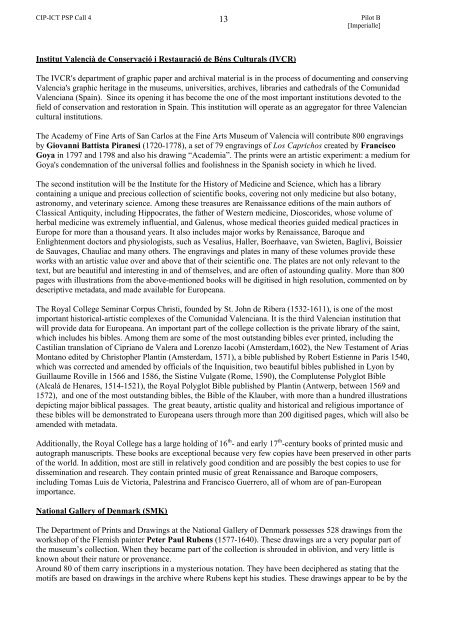proposal part b - The Bernstein Project
proposal part b - The Bernstein Project
proposal part b - The Bernstein Project
Create successful ePaper yourself
Turn your PDF publications into a flip-book with our unique Google optimized e-Paper software.
CIP-ICT PSP Call 4 13<br />
Pilot B<br />
[Imperialle]<br />
Institut Valencià de Conservació i Restauració de Béns Culturals (IVCR)<br />
<strong>The</strong> IVCR's de<strong>part</strong>ment of graphic paper and archival material is in the process of documenting and conserving<br />
Valencia's graphic heritage in the museums, universities, archives, libraries and cathedrals of the Comunidad<br />
Valenciana (Spain). Since its opening it has become the one of the most important institutions devoted to the<br />
field of conservation and restoration in Spain. This institution will operate as an aggregator for three Valencian<br />
cultural institutions.<br />
<strong>The</strong> Academy of Fine Arts of San Carlos at the Fine Arts Museum of Valencia will contribute 800 engravings<br />
by Giovanni Battista Piranesi (1720-1778), a set of 79 engravings of Los Caprichos created by Francisco<br />
Goya in 1797 and 1798 and also his drawing “Academia”. <strong>The</strong> prints were an artistic experiment: a medium for<br />
Goya's condemnation of the universal follies and foolishness in the Spanish society in which he lived.<br />
<strong>The</strong> second institution will be the Institute for the History of Medicine and Science, which has a library<br />
containing a unique and precious collection of scientific books, covering not only medicine but also botany,<br />
astronomy, and veterinary science. Among these treasures are Renaissance editions of the main authors of<br />
Classical Antiquity, including Hippocrates, the father of Western medicine, Dioscorides, whose volume of<br />
herbal medicine was extremely influential, and Galenus, whose medical theories guided medical practices in<br />
Europe for more than a thousand years. It also includes major works by Renaissance, Baroque and<br />
Enlightenment doctors and physiologists, such as Vesalius, Haller, Boerhaave, van Swieten, Baglivi, Boissier<br />
de Sauvages, Chauliac and many others. <strong>The</strong> engravings and plates in many of these volumes provide these<br />
works with an artistic value over and above that of their scientific one. <strong>The</strong> plates are not only relevant to the<br />
text, but are beautiful and interesting in and of themselves, and are often of astounding quality. More than 800<br />
pages with illustrations from the above-mentioned books will be digitised in high resolution, commented on by<br />
descriptive metadata, and made available for Europeana.<br />
<strong>The</strong> Royal College Seminar Corpus Christi, founded by St. John de Ribera (1532-1611), is one of the most<br />
important historical-artistic complexes of the Comunidad Valenciana. It is the third Valencian institution that<br />
will provide data for Europeana. An important <strong>part</strong> of the college collection is the private library of the saint,<br />
which includes his bibles. Among them are some of the most outstanding bibles ever printed, including the<br />
Castilian translation of Cipriano de Valera and Lorenzo Iacobi (Amsterdam,1602), the New Testament of Arias<br />
Montano edited by Christopher Plantin (Amsterdam, 1571), a bible published by Robert Estienne in Paris 1540,<br />
which was corrected and amended by officials of the Inquisition, two beautiful bibles published in Lyon by<br />
Guillaume Roville in 1566 and 1586, the Sistine Vulgate (Rome, 1590), the Complutense Polyglot Bible<br />
(Alcalá de Henares, 1514-1521), the Royal Polyglot Bible published by Plantin (Antwerp, between 1569 and<br />
1572), and one of the most outstanding bibles, the Bible of the Klauber, with more than a hundred illustrations<br />
depicting major biblical passages. <strong>The</strong> great beauty, artistic quality and historical and religious importance of<br />
these bibles will be demonstrated to Europeana users through more than 200 digitised pages, which will also be<br />
amended with metadata.<br />
Additionally, the Royal College has a large holding of 16 th - and early 17 th -century books of printed music and<br />
autograph manuscripts. <strong>The</strong>se books are exceptional because very few copies have been preserved in other <strong>part</strong>s<br />
of the world. In addition, most are still in relatively good condition and are possibly the best copies to use for<br />
dissemination and research. <strong>The</strong>y contain printed music of great Renaissance and Baroque composers,<br />
including Tomas Luis de Victoria, Palestrina and Francisco Guerrero, all of whom are of pan-European<br />
importance.<br />
National Gallery of Denmark (SMK)<br />
<strong>The</strong> De<strong>part</strong>ment of Prints and Drawings at the National Gallery of Denmark possesses 528 drawings from the<br />
workshop of the Flemish painter Peter Paul Rubens (1577-1640). <strong>The</strong>se drawings are a very popular <strong>part</strong> of<br />
the museum’s collection. When they became <strong>part</strong> of the collection is shrouded in oblivion, and very little is<br />
known about their nature or provenance.<br />
Around 80 of them carry inscriptions in a mysterious notation. <strong>The</strong>y have been deciphered as stating that the<br />
motifs are based on drawings in the archive where Rubens kept his studies. <strong>The</strong>se drawings appear to be by the









